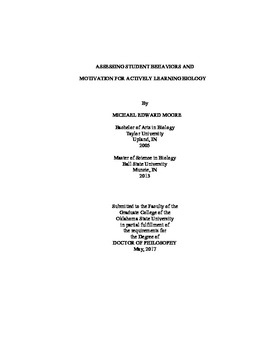| dc.contributor.advisor | French, Donald P. | |
| dc.contributor.author | Moore, Michael Edward | |
| dc.date.accessioned | 2018-03-13T18:16:10Z | |
| dc.date.available | 2018-03-13T18:16:10Z | |
| dc.date.issued | 2017-05 | |
| dc.identifier.uri | https://hdl.handle.net/11244/54576 | |
| dc.description.abstract | Vision and Change states that one of the major changes in the way we design biology courses should be a switch in approach from teacher-centered learning to student-centered learning and identifies active learning as a recommended methods. Studies show performance benefits for students taking courses that use active learning. What is unknown is why active learning is such an effective instructional tool and the limits of this instructional method's ability to influence performance. This dissertation builds a case in three steps for why active learning is an effective instructional tool. In step one, I assessed the influence of different types of active learning (clickers, group activities, and whole class discussions) on student engagement behavior in one semester of two different introductory biology courses and found that active learning positively influenced student engagement behavior significantly more than lecture. For step two, I examined over four semesters whether student engagement behavior was a predictor of performance and found participation (engagement behavior) in the online (video watching) and in-class course activities (clicker participation) that I measure were significant predictors of performance. In the third, I assessed whether certain active learning satisfied the psychological needs that lead to students' intrinsic motivation to participate in those activities when compared over two semesters and across two different institutions of higher learning. Findings from this last step show us that student's perceptions of autonomy, competency, and relatedness in doing various types of active learning are significantly higher than lecture and consistent across two institutions of higher learning. Lastly, I tie everything together, discuss implications of the research, and address future directions for research on biology student motivation and behavior. | |
| dc.format | application/pdf | |
| dc.language | en_US | |
| dc.rights | Copyright is held by the author who has granted the Oklahoma State University Library the non-exclusive right to share this material in its institutional repository. Contact Digital Library Services at lib-dls@okstate.edu or 405-744-9161 for the permission policy on the use, reproduction or distribution of this material. | |
| dc.title | Assessing student behaviors and motivation for actively learning biology | |
| dc.contributor.committeeMember | McBee, Karen | |
| dc.contributor.committeeMember | Cho, YoonJung | |
| dc.contributor.committeeMember | Nyari, Arpad | |
| dc.contributor.committeeMember | Davis, Robert Evan | |
| osu.filename | Moore_okstate_0664D_15244.pdf | |
| osu.accesstype | Open Access | |
| dc.type.genre | Dissertation | |
| dc.type.material | Text | |
| thesis.degree.discipline | Integrative Biology | |
| thesis.degree.grantor | Oklahoma State University | |
